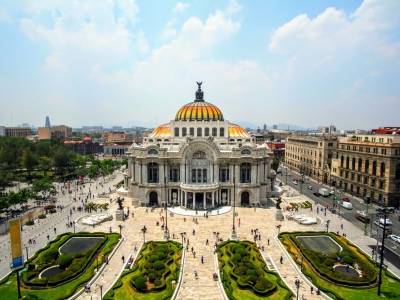-
墨西哥
The Distribution of wine in Mexico
7 3 月 2021
- 分销协议
Wine Market in Mexico 2020-2021
The wine market in Mexico has shown an annual growth of approximately 8% during the past 5 years.
Importations have increased during the past 10 years, increasing its value in 88%.
Mexico has the second highest consumption growth rate worldwide according to the International Organization of Vine and Wine (OIV).
Current Trends in Mexico
Mexican wines accounted for 29% of Mexico’s consumption, while the remaining 71% corresponds to imported wines.
Wine consumption is primarily concentrated in 3 cities, Mexico City, Monterrey, and Guadalajara, with a potential increase in touristic locations.
Due to the health contingency generated as a result of the COVID19, on-line sales of the various supermarkets have increased in 300% during 2020.
Digitalization of processes represents a huge potential in terms of sales’ increase, and are expected to grow in a 40% yearly.
Consumers in Mexico are under 45 years old, having a pretty good balance in terms of gender (55% male and 45 female).
Types of wine consumed (71% red, 11% white, 9% sparkling, and 9% rose and others).
Comparison of wine consumption per capita
Following we share the following available information to illustrate differences between specific countries on current wine consumption per capita.
| Country | Consumption per capita |
| France | 49.5 lts |
| Italy | 43.0 lts |
| Austria | 29.4 lts |
| Spain | 27.8 lts |
| United States | 10.14 lts |
| China | 1.7 lts |
| Brazil | 1.6 lts |
| Mexico | 1.34 lts |
For more information you can visit our country guide on wine distribution in Mexico and watch the following video
The parliamentary fraction of Morena (party with majority in Congress) recently filed an initiative to reform the Federal Labor Law (FLL); this modification aims to set forth an obligation for employers to implement an action protocol to prevent gender-based discrimination and to manage violence and sexual harassment cases.
Although this type of conducts are considered in the FLL as a cause for rescission both for the employer and for the employee, with penalties for employers who incur, tolerate or allow them, around $18K pesos (US $1K) to $365K pesos (US $20K) approx., the reform aims to guarantee the existence of a mechanism to effectively protect the worker’s right to decent treatment and equality.
The Ministry of Labor and Social Welfare (MLSW) currently has a model attention protocol for workplace violence in order to promote the implementation by Mexican companies of policies and actions to detect and prevent this type of situations.
The MLSW proposes the creation of a commission incorporated by representatives of the company and the employees, with the main purposes of:
· Implementing the aforementioned protocol;
· Receiving, managing and solving complaints filed by employees related to workplace violence; and,
· Imposing the corresponding penalties to the employees in the work environment, which shall be set forth in the Internal Workplace Regulations effective for the company.
In order for the protocol to be an effective mechanism to counter these types of conducts within the workplace, it is recommended that such protocol sets forth, at least the following:
· Diagnostic processes allowing to determine the risk level of the company to determine the most appropriate preventive measures.
· Awareness and training actions promoting violence free workplaces, allowing workers to clearly identify if they are victims of such types of conducts, the instances to which they can resort and the steps to file a complaint.
· Mechanisms available for the workers to report these type of incidents.
· Processes to investigate the reported incidents.
· Guidelines to determine the penalties applicable to the workers incurring in such types of conducts.
Considering the approval of such reform is imminent and in order to guarantee compliance to it at the date of its publication and effectiveness, it is convenient that companies initiate the implementation of their compliance systems to prevent any penalty that may arise from an inspection visit of the MLSW.
It is worth mentioning that these systems do not only serve a compliance purpose, since them also bright forth multiple benefits for companies regarding prevention of operative, labor and legal risks.
It is known that denigrating practices in the workplace are one of the common causes of absenteeism, staff turnover and drop in performance. These situations have negative economic impact in companies, both in their costs and in their productivity.
The implementation of an effective compliance system allows ensuring a respectful behavior within the organization, creating a healthy workplace environment which helps to reduce such incidents and supports the capabilities of the human capital, enabling companies to meet their commercial and financial goals.
These systems also contribute to reduce the risks of exposure of companies to such claims on behalf of their workers, and also the contingencies and liabilities that may derive from them, whether under labor, civil or criminal law.
On December 30, 2018, the Comprehensive and Progressive Agreement For Trans-Pacific Partnership (“CPTPP”) entered into force
This Treaty is considered the third largest global trade agreement, positioned after the Comprehensive Economic and Trade Agreement between Canada and the EU (“CETA”) and the United States–Mexico–Canada Agreement (“USMCA”). The CPTPP sets forth a model of trade liberalization, aiming to maintain the markets open, increase world trade and create new economic opportunities for the member countries.
The CPTPP reaffirms and materializes a major part of the provisions of the Trans-Pacific Economic Cooperation Agreement (“TPP”), which had been originally signed by 12 countries, subsequently the United States of America (“USA”) announced its withdrawal.
As a result, this Treaty is the agreement reached by the remaining 11 countries of the TPP (Australia, Brunei, Canada, Chile, Japan, Malaysia, Mexico, New Zealand, Peru, Singapore and Vietnam) in an effort to enact its provisions, since the original text is incorporated, except for 22 provisions related to rules presented by the USA, which were suspended.
The Agreement has four main characteristics:
- Improves the access to the markets of the participating countries, eliminating and reducing tariff barriers amongst them. It also increases the pre-existing benefits between countries which had already entered into an agreement.
- Promotes innovation, productivity and competition;
- Encourages inclusive commerce, by incorporating new elements to ensure economic development, such as regulating the activities of state-owned companies, intellectual property, regulatory coherence, electronic commerce and support to Small and Medium Enterprises (“SMEs“) in order to streamline and simplify trade.
- Through a regional integration platform, it aims to enhance the production chain and the possibility of including different and future economies.
To estimate the relevance of the Agreement, the Mexican Ministry of Economy stated that, although the absence of the USA reduced the economic dimensions of the market delimited by this instrument (from 40% to 13% of the world economy), future prospects are favorable since: i) the participation of the 11 countries, creates a market of 500 million consumers, ii) 13.5% of the world’s Gross Domestic Product (GDP) will enter in to this market and iii) the likelihood of incorporation of other countries is probable, which could compensate the absence of the USA.
With the CPTPP, Mexico intends to broaden its trade openness in the most dynamic zone in the world (Asia-Pacific), allowing Mexican products to enter into 6 new countries: Australia, Brunei, Malaysia, New Zealand, Singapore and Vietnam. The aforementioned will promote the diversification of the trade economic activity, bolstering sectors such as agriculture, automotive, aerospace and products such as medical devices, electrical equipment, dairy products, tuna, sardines, cosmetics, tequila, mezcal, beer, etc.
This Agreement will also deepen the access to the Japanese market and will consolidate tariff preferences with countries with which a free trade agreement had already been signed, such as Canada, Chile and Peru.
The main motivation of the Mexican government in the negotiation of the CPTPP is to continue with a trade liberalization policy that began in 1989. Currently, Mexico has a network of 12 free trade agreements with 46 countries; 33 agreements for the reciprocal promotion of investments; and 9 agreements of limited scope (Economic Complementation Agreements and Partial Scope Agreements) within the framework of the Latin American Integration Association.
2018年5月18日,《联邦官方公报》公布了对《工业产权法》(IPL)的改革,将于2018年8月10日生效。由于部分修订与业务有关,我们拟备了以下附注:
使用声明商标持有人有义务在获得注册的第三年后的三个月内提交使用声明。如果所有权人不提交声明,登记即行结束。
商标保护的范围。新的元素可以通过商标注册得到保护,其中包括:
- 气味和声音商标。独特的气味和声音可以通过商标注册来保护。
- 全息影像商标。这些商标现在可以用商标注册来保护。
- 认证商标。这些标志区分产品和服务,其质量或特征已由商标的持有人认证,如部件、制造条件、质量等。
- 商业外观保护。大量操作上的和图像上的元素,例如:尺寸,颜色,标签,包装,装饰以及任何其他元素,当他们组合起来时,就会造成市场中产品和服务的差别,让他们作为商标被保护。
商标注册障碍。对商标注册的障碍进行了修正和补充。值得强调的是将公司恶意备案作为登记的一个障碍。在这种情况下,登记是违背良好做法、传统和习俗提出的,或者登记的目的是获得影响到其合法所有人的不正当利益或好处。
同样,值得一提的是,承认通过提交有关当事方的书面同意,可以防止某些登记障碍,例如,类似商标的登记,在保护相同产品或服务的先前登记方面,达到令人困惑的程度。
起诉制度。当事方将被允许提出证据和随后提出最后的起诉状,而不中断登记程序的期限。
撤销权诉讼时效制度。因先前使用而申请撤销商标的时效期限从3年延长至5年。
根据《工业产权法》的修正案,有必要更新《条例》,以阐明新条例的实际方面。想了解更多信息,请不要犹豫通过Legalmondo与我联系。
On June 14, 2018, a reform to articles 73 and 129 of the General Law of Business Corporations (“GLBC”) was published in the Official Gazette of the Federation, which will become effective on December 15, 2018.
This amendment establishes an obligation to give notice of the entries made in the partners and shares’ registry books that record the transfer of partnership interests and shares in limited liability companies and stock corporations.
In both type of companies, the notice must be published in the electronic system established by the Ministry of Economy (“SE”), being effective as of the day following its publication, in accordance with the provisions of Article 50-bis of the Commercial Code.
Additionally, in the case of stock corporations, the SE will ensure that the name, nationality and address of the shareholder contained in the notice are kept as confidential, except in cases where the information is requested by judicial or administrative authorities, when necessary to exercise its authority. The amendment does not grant the same confidentiality protection to the information of the limited liability companies, since it distinguishes the personal nature of the partners with respect to the shareholders in a stock corporation.
This amendment derives from Recommendation 24 of the Financial Action Task Force (“FATF”), relating to the unlawful use of entities for money-laundering, terrorist financing and proliferation of weapons of mass destruction. It will be desirable that this amendment contributes to transparent information, which today is not possible to obtain from the Public Registries of Commerce, which scenario contain certain information on the partners or shareholders, not updated, and which search is cumbersome while existing many at a local level throughout all the Mexican Republic.
Finally, it bears noting that the amendment establishes no penalty for failing to file such notices.
写信给 Joaquin
Mexico – Action protocol for discrimination and workplace violence
12 3 月 2019
-
墨西哥
- 公司法
Wine Market in Mexico 2020-2021
The wine market in Mexico has shown an annual growth of approximately 8% during the past 5 years.
Importations have increased during the past 10 years, increasing its value in 88%.
Mexico has the second highest consumption growth rate worldwide according to the International Organization of Vine and Wine (OIV).
Current Trends in Mexico
Mexican wines accounted for 29% of Mexico’s consumption, while the remaining 71% corresponds to imported wines.
Wine consumption is primarily concentrated in 3 cities, Mexico City, Monterrey, and Guadalajara, with a potential increase in touristic locations.
Due to the health contingency generated as a result of the COVID19, on-line sales of the various supermarkets have increased in 300% during 2020.
Digitalization of processes represents a huge potential in terms of sales’ increase, and are expected to grow in a 40% yearly.
Consumers in Mexico are under 45 years old, having a pretty good balance in terms of gender (55% male and 45 female).
Types of wine consumed (71% red, 11% white, 9% sparkling, and 9% rose and others).
Comparison of wine consumption per capita
Following we share the following available information to illustrate differences between specific countries on current wine consumption per capita.
| Country | Consumption per capita |
| France | 49.5 lts |
| Italy | 43.0 lts |
| Austria | 29.4 lts |
| Spain | 27.8 lts |
| United States | 10.14 lts |
| China | 1.7 lts |
| Brazil | 1.6 lts |
| Mexico | 1.34 lts |
For more information you can visit our country guide on wine distribution in Mexico and watch the following video
The parliamentary fraction of Morena (party with majority in Congress) recently filed an initiative to reform the Federal Labor Law (FLL); this modification aims to set forth an obligation for employers to implement an action protocol to prevent gender-based discrimination and to manage violence and sexual harassment cases.
Although this type of conducts are considered in the FLL as a cause for rescission both for the employer and for the employee, with penalties for employers who incur, tolerate or allow them, around $18K pesos (US $1K) to $365K pesos (US $20K) approx., the reform aims to guarantee the existence of a mechanism to effectively protect the worker’s right to decent treatment and equality.
The Ministry of Labor and Social Welfare (MLSW) currently has a model attention protocol for workplace violence in order to promote the implementation by Mexican companies of policies and actions to detect and prevent this type of situations.
The MLSW proposes the creation of a commission incorporated by representatives of the company and the employees, with the main purposes of:
· Implementing the aforementioned protocol;
· Receiving, managing and solving complaints filed by employees related to workplace violence; and,
· Imposing the corresponding penalties to the employees in the work environment, which shall be set forth in the Internal Workplace Regulations effective for the company.
In order for the protocol to be an effective mechanism to counter these types of conducts within the workplace, it is recommended that such protocol sets forth, at least the following:
· Diagnostic processes allowing to determine the risk level of the company to determine the most appropriate preventive measures.
· Awareness and training actions promoting violence free workplaces, allowing workers to clearly identify if they are victims of such types of conducts, the instances to which they can resort and the steps to file a complaint.
· Mechanisms available for the workers to report these type of incidents.
· Processes to investigate the reported incidents.
· Guidelines to determine the penalties applicable to the workers incurring in such types of conducts.
Considering the approval of such reform is imminent and in order to guarantee compliance to it at the date of its publication and effectiveness, it is convenient that companies initiate the implementation of their compliance systems to prevent any penalty that may arise from an inspection visit of the MLSW.
It is worth mentioning that these systems do not only serve a compliance purpose, since them also bright forth multiple benefits for companies regarding prevention of operative, labor and legal risks.
It is known that denigrating practices in the workplace are one of the common causes of absenteeism, staff turnover and drop in performance. These situations have negative economic impact in companies, both in their costs and in their productivity.
The implementation of an effective compliance system allows ensuring a respectful behavior within the organization, creating a healthy workplace environment which helps to reduce such incidents and supports the capabilities of the human capital, enabling companies to meet their commercial and financial goals.
These systems also contribute to reduce the risks of exposure of companies to such claims on behalf of their workers, and also the contingencies and liabilities that may derive from them, whether under labor, civil or criminal law.
On December 30, 2018, the Comprehensive and Progressive Agreement For Trans-Pacific Partnership (“CPTPP”) entered into force
This Treaty is considered the third largest global trade agreement, positioned after the Comprehensive Economic and Trade Agreement between Canada and the EU (“CETA”) and the United States–Mexico–Canada Agreement (“USMCA”). The CPTPP sets forth a model of trade liberalization, aiming to maintain the markets open, increase world trade and create new economic opportunities for the member countries.
The CPTPP reaffirms and materializes a major part of the provisions of the Trans-Pacific Economic Cooperation Agreement (“TPP”), which had been originally signed by 12 countries, subsequently the United States of America (“USA”) announced its withdrawal.
As a result, this Treaty is the agreement reached by the remaining 11 countries of the TPP (Australia, Brunei, Canada, Chile, Japan, Malaysia, Mexico, New Zealand, Peru, Singapore and Vietnam) in an effort to enact its provisions, since the original text is incorporated, except for 22 provisions related to rules presented by the USA, which were suspended.
The Agreement has four main characteristics:
- Improves the access to the markets of the participating countries, eliminating and reducing tariff barriers amongst them. It also increases the pre-existing benefits between countries which had already entered into an agreement.
- Promotes innovation, productivity and competition;
- Encourages inclusive commerce, by incorporating new elements to ensure economic development, such as regulating the activities of state-owned companies, intellectual property, regulatory coherence, electronic commerce and support to Small and Medium Enterprises (“SMEs“) in order to streamline and simplify trade.
- Through a regional integration platform, it aims to enhance the production chain and the possibility of including different and future economies.
To estimate the relevance of the Agreement, the Mexican Ministry of Economy stated that, although the absence of the USA reduced the economic dimensions of the market delimited by this instrument (from 40% to 13% of the world economy), future prospects are favorable since: i) the participation of the 11 countries, creates a market of 500 million consumers, ii) 13.5% of the world’s Gross Domestic Product (GDP) will enter in to this market and iii) the likelihood of incorporation of other countries is probable, which could compensate the absence of the USA.
With the CPTPP, Mexico intends to broaden its trade openness in the most dynamic zone in the world (Asia-Pacific), allowing Mexican products to enter into 6 new countries: Australia, Brunei, Malaysia, New Zealand, Singapore and Vietnam. The aforementioned will promote the diversification of the trade economic activity, bolstering sectors such as agriculture, automotive, aerospace and products such as medical devices, electrical equipment, dairy products, tuna, sardines, cosmetics, tequila, mezcal, beer, etc.
This Agreement will also deepen the access to the Japanese market and will consolidate tariff preferences with countries with which a free trade agreement had already been signed, such as Canada, Chile and Peru.
The main motivation of the Mexican government in the negotiation of the CPTPP is to continue with a trade liberalization policy that began in 1989. Currently, Mexico has a network of 12 free trade agreements with 46 countries; 33 agreements for the reciprocal promotion of investments; and 9 agreements of limited scope (Economic Complementation Agreements and Partial Scope Agreements) within the framework of the Latin American Integration Association.
2018年5月18日,《联邦官方公报》公布了对《工业产权法》(IPL)的改革,将于2018年8月10日生效。由于部分修订与业务有关,我们拟备了以下附注:
使用声明商标持有人有义务在获得注册的第三年后的三个月内提交使用声明。如果所有权人不提交声明,登记即行结束。
商标保护的范围。新的元素可以通过商标注册得到保护,其中包括:
- 气味和声音商标。独特的气味和声音可以通过商标注册来保护。
- 全息影像商标。这些商标现在可以用商标注册来保护。
- 认证商标。这些标志区分产品和服务,其质量或特征已由商标的持有人认证,如部件、制造条件、质量等。
- 商业外观保护。大量操作上的和图像上的元素,例如:尺寸,颜色,标签,包装,装饰以及任何其他元素,当他们组合起来时,就会造成市场中产品和服务的差别,让他们作为商标被保护。
商标注册障碍。对商标注册的障碍进行了修正和补充。值得强调的是将公司恶意备案作为登记的一个障碍。在这种情况下,登记是违背良好做法、传统和习俗提出的,或者登记的目的是获得影响到其合法所有人的不正当利益或好处。
同样,值得一提的是,承认通过提交有关当事方的书面同意,可以防止某些登记障碍,例如,类似商标的登记,在保护相同产品或服务的先前登记方面,达到令人困惑的程度。
起诉制度。当事方将被允许提出证据和随后提出最后的起诉状,而不中断登记程序的期限。
撤销权诉讼时效制度。因先前使用而申请撤销商标的时效期限从3年延长至5年。
根据《工业产权法》的修正案,有必要更新《条例》,以阐明新条例的实际方面。想了解更多信息,请不要犹豫通过Legalmondo与我联系。
On June 14, 2018, a reform to articles 73 and 129 of the General Law of Business Corporations (“GLBC”) was published in the Official Gazette of the Federation, which will become effective on December 15, 2018.
This amendment establishes an obligation to give notice of the entries made in the partners and shares’ registry books that record the transfer of partnership interests and shares in limited liability companies and stock corporations.
In both type of companies, the notice must be published in the electronic system established by the Ministry of Economy (“SE”), being effective as of the day following its publication, in accordance with the provisions of Article 50-bis of the Commercial Code.
Additionally, in the case of stock corporations, the SE will ensure that the name, nationality and address of the shareholder contained in the notice are kept as confidential, except in cases where the information is requested by judicial or administrative authorities, when necessary to exercise its authority. The amendment does not grant the same confidentiality protection to the information of the limited liability companies, since it distinguishes the personal nature of the partners with respect to the shareholders in a stock corporation.
This amendment derives from Recommendation 24 of the Financial Action Task Force (“FATF”), relating to the unlawful use of entities for money-laundering, terrorist financing and proliferation of weapons of mass destruction. It will be desirable that this amendment contributes to transparent information, which today is not possible to obtain from the Public Registries of Commerce, which scenario contain certain information on the partners or shareholders, not updated, and which search is cumbersome while existing many at a local level throughout all the Mexican Republic.
Finally, it bears noting that the amendment establishes no penalty for failing to file such notices.






















